“Don’t train. Be careful! You shouldn’t do that!”
Those were the most common pieces of well-intentioned “advice” I heard during my two pregnancies. While I appreciated people’s concern for my and my baby’s well-being, I was annoyed at the sheer volume of poor information available and being spread about the importance of staying active and exercising during pregnancy.
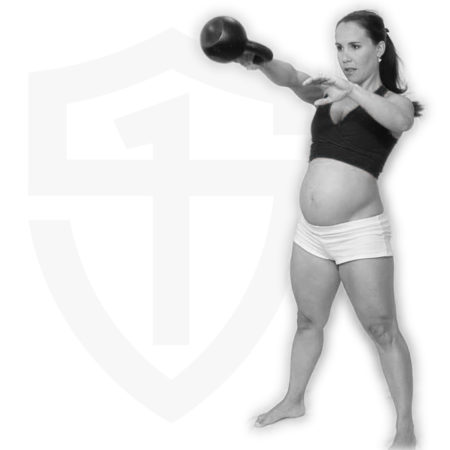
Is pregnancy a type of disease? Should being pregnant be used as an “excuse” to sideline healthy habits—eating well and staying active? The answer is NO!
Nevertheless, there is an important line that you don’t want to cross. Pregnancy is not the time to stay on the couch, eating whatever you want. But neither is it the time to test your mettle, chasing PRs, taking grueling certifications, or looking to show off.
Pregnancy Is the Time to Be a Super Mom!
I have had the privilege to train several women through their pregnancy and seen many more sharing their experiences through social media. Pregnancy is one of God’s greatest blessings. Admittedly, it’s not all rainbows and unicorns. Seeing (and feeling) your body transform (especially outside of the baby bump) can be alarming; even depressing at times. The good news is that the episodes of nausea, moody highs and lows, cravings, and aches, are worthy prices we pay for these blessings. But how can we navigate staying strong and healthy throughout while honoring the shift in our focus—growing a new life?
New moms are riddled with training related questions: What’s safe? What to avoid? How much? Believe me, I understand—I had them too.
First, we must celebrate: pregnancy is NOT an illness, disease, or impairment. It’s a natural process to embrace and an opportunity to become our growing baby’s “super mom.”
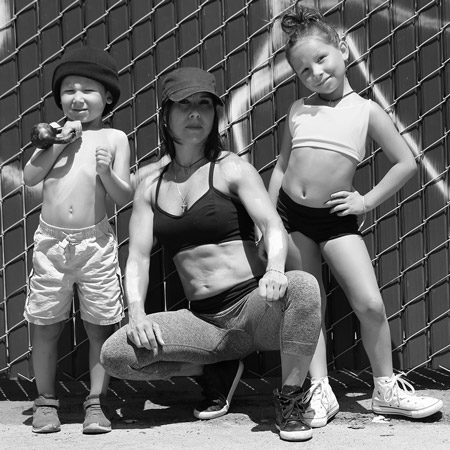
Which Program Should I Follow? Where Do I Start?
Unfortunately, there is no magic, one-size-fits-all program for you to follow. Every pregnancy is different and you must accept that on some days you will feel awesome, strong, and energized, while on others, sleep will be all you want. That’s ok! It’s important that you learn to listen to your body—your growing baby has its own agenda and is calling the shots now.
It is also important to keep an open communication with your doctor about your exercise plans. According to the guideline of the American College of Obstetricians and Gynecologists (ACOG), women can and should exercise during pregnancy, unless there are medical reasons to avoid it. Be sure to get clearance for your intended physical activity. However, from my personal experience, I recommend that you be picky about selecting your doctor to identify their biases about exercise. Some medical professionals, who may not exercise themselves or have not had many already strong and fit patients, may be incredibly risk averse. You have every right to ask questions of who will offer you health and wellness advice.
With that said, here are three foundational fitness components to prioritize in your pregnancy training:
- Stability, mobility, and flexibility. Stability is the central and most important bio-motor ability for pregnant women, especially as our connective tissues progressively relax. It is defined as the ability to maintain posture and control motion. Maintaining appropriate flexibility (without chasing end ranges) and mobility is very important to keep the body functioning at a high level.
- Strength and power. Maintaining your strength and power will definitely help you as your pregnancy progresses and for your delivery. Strength and power exercises are a natural progression out of the stability exercises.
- Endurance and conditioning. Maintaining adequate endurance will help with the ability to resist fatigue in daily situations, thereby keeping good energy reserves for your baby’s development. The conditioning aspect becomes increasingly important after the birth because new moms must balance mothering needy babies while still having to take on the other pressures of life.
Additional fitness considerations:
- Even the fittest must shift their focus. Pregnancy it is not the time to chase personal records and try to test the edge of your capabilities. It is time to create the optimal internal and external environment for the baby.
- As your pregnancy progresses, some movements may become contraindicated. Be sure to ask your doctor about those details so you can adapt your training.
- Pregnancy is generally not easy as our body faces strong changes. For this reason, a training plan and positive attitude make a big difference in how we respond and adapt to pregnancy stresses.
- Pregnancy is not the time to be loose and let our body become weak. On the contrary, keeping ourselves healthy and strong during pregnancy will lessen the stress of the process, make us more resilient, and help us return to our physical form more quickly—being “super mommy.”
- Listen to your body and use common sense.
And finally, two notes about nutrition:
- Nutrition plays a vital role during pregnancy to ensure you feel healthy and create an optimal environment for your baby to grow. During pregnancy, you will absolutely need additional nutrients, but that does not mean that you should eat for two. Many women overgrow during pregnancy because they consume far above what they need: approximately 200-300 extra calories are required each day, depending on your starting body size.
- Remember, everything you do or consume is shared with your baby. An exaggerated increase in weight will not only require more of your energy reserves for every basic activity, but it will also make it harder to recover after giving birth. However, this could also apply if you try to cross the line between being healthy and taking your body into an extreme training program while pregnant. Every woman and every pregnancy is different, so “listen to your body.”
What If You Are Not Pregnant Yet?
Whether you are planning on getting pregnant this year or in five more years, my best advice is to get your body ready now. Having a solid strength and endurance foundation is the key to having a pleasant pregnancy, easy delivery, and fast recovery. And the best time to build it is BEFORE you become pregnant. Healthy babies start with healthy moms!
I was able to stay very active and train during my pregnancies because I went into them fit and strong. It is much easier to stay active once pregnant when you already have a strength foundation and good fitness habits. That is why I always encourage women to prioritize their health and get/stay in shape at all times.
I was fortunate to have incredible doctors deliver my babies and the entire medical staff was shocked from how easy and “fun” both of my labors were and how quickly I recovered. Without a doubt, my training before and throughout pregnancy played a huge role in the ease of my birthing process.
Why Train with Kettlebells and StrongFirst Principles?
Kettlebells may be the best secret that mother Russia kept from the West for centuries. Kettlebells deliver extreme all-round fitness—and no single other tool does it better. You train strength, flexibility, and cardio just with one compact tool. It is the perfect “gym” to have at home, especially on days or weeks where you don’t want to leave because your energy may be lower or you have a newborn to care for. Having a few tools at home and knowing how to use them safely can make the difference between maintaining your fitness and a slow decline.
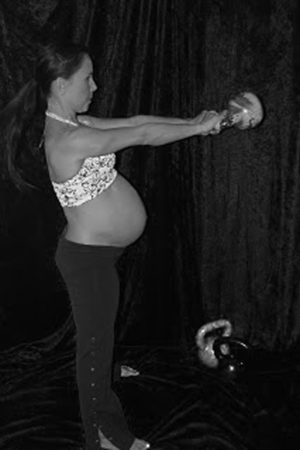
Training using StrongFirst principles with kettlebells and bodyweight movements will give you the time to get strong anywhere, anytime, and on your schedule—because you won’t need to travel to a gym, you can split up your training throughout the day, and ensure adequate rest. The primary reason that I chose kettlebells during my pregnancy was that I knew how resilient my body had become through using them prior to getting pregnant. That allowed me transition into a less intense kettlebell practice and maintain a decent level of fitness throughout each pregnancy.
Two of My Favorite Pregnancy Training Sessions
Session 1: Kettlebell Supersets
Complete A1 for 3 sets. Then B1&B2 as a superset, for 2-3 sets. Finally, complete C1&C2 as a superset, for 2-3 sets.
- A1) Single Leg Deadlift 6R/6L
- Rest 60 seconds or as much as you need between sets; repeat 3 times.
- B1) Snatch x 10R/10L
- B2) Single Bent Over Row x 8R/8L
- Rest 90 seconds or as much as you need between sets; repeat 2-3 times.
- C1) Single Clean + Squat + Press x 5R/5L
- C2) Two-handed Swing x 15 reps
- Rest 90 seconds or as much as you need between sets; repeat 2-3 times.
Session 2: Kettlebell Circuit
Complete A1-A4 as a circuit and repeat 5 times.
- A1) Goblet Squat x 5 reps
- A2) Single Arm Press x 5R/5L
- A3) Side Plank x 30 seconds per side
- A4) Two-handed Swings x 20 reps
- Rest 90 seconds or as much as you need between circuits; repeat 5 times.
How Soon Can I Start Exercising After Having a Baby?
I can certainly relate to wanting to get back into training after your baby is born. However, it’s important to follow your doctor’s guidance as he or she has specific knowledge of your pregnancy and birth. Adapting to pregnancy requires profound physical changes, including a loosening and stretching of ligaments and other connective tissue in your abdominals, core, and pelvic floor, with postural adaptations to balance a growing tummy. This “stretching” and “loosening” effect, while absolutely desirable for the baby, can leave women with instability in the lumbar, sacral, hip, and pelvic joints. This lack of stability can make it challenging to return to normal daily movements let alone regular strength training and compound kettlebell movements.
Therefore, once cleared by your doctor, you can start training with corrective exercises like clamshells, bird dogs, and posterior rocks. After one or two weeks and assuming no pregnancy or birth complications, I would re-introduce some foundational kettlebell movements like deadlifts, squats, lunges, swings, cleans, and presses, using conservative loads. Be sure to focus on quality movements while keeping your volume and intensity light, as you rebuild your stability, strength, and stamina. Ten to twenty minutes, three to four times per week will be effective.
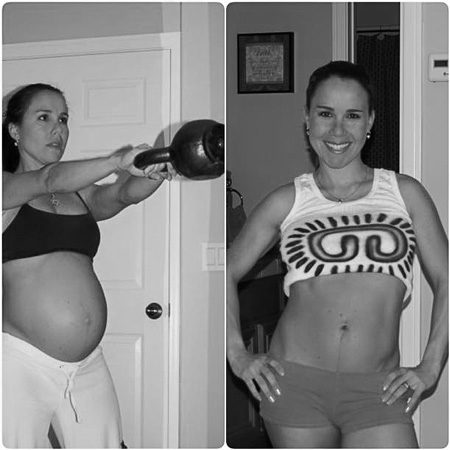
The Best Time to Get Fit Is Now
Whether you are contemplating a future pregnancy or are newly pregnant, making sure you get and stay strong will have a huge impact on your experience. By focusing on quality movements, listening to your body to adapt the volume, intensity, and movements as your belly grows, you will be a super mommy ready for your baby to arrive. Every pregnant woman I have trained has found their journey to be easier—from pregnancy to delivery, and throughout recovery.
How Do I Start?
So…Are you ready to swing some kettlebells?
If you want to learn how to lift and carry external resistance (which your baby will be) with excellent form to get and stay strong, you have a few options. Ideally, every want-to-be and soon-to-be mom would have access to a strength coach with pre-natal training. This becomes more important if you are new to exercise and are starting out later in your pregnancy. But for others—new to strength training and/or kettlebells who aren’t pregnant yet or just newly so (first trimester)—I would recommend learning proper lifting technique as a foundation to future strength. We have two live course options that will do exactly that, under the eye of an expert instructor. First, for those who want to experience strength using kettlebells, we offer one-day StrongFirst Kettlebell Courses worldwide. Next is our new Foundations Course. It’s a special half-day teaser, where you’ll experience how strength transcends the tools you choose—kettlebell, barbell or bodyweight—and has everything to do with how you move your body.
For those already proficient with strength training, I highly recommend Pavel’s Strong Endurance™ seminar. While pregnancy is not a covered topic, you will learn the keys to “be always ready and at your maximum level of health.” Understanding how stress affects our body, the cost of adaptation, relaxation, efficiency, breathing, and planning will put you on the right road.


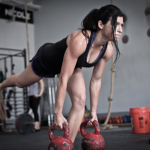



Really great! Well written article and a hot topic in much of the healthcare world too. Thank you.
More articles like this on applying StrongFirst principles to a variety of populations and health issues. Well done.